Order: Accipitriformes
Family: Accipitridae
Genus: Buteo
Species: B. jamaicensis
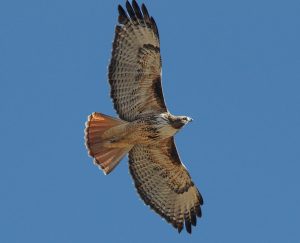
Bird Red Tailed Hawk Wildlife Hunter Flying Raptor https://www.maxpixel.net/Bird-Red-Tailed-Hawk-Wildlife-Hunter-Flying-Raptor-1712098
Red-tailed hawks can be found throughout North and Central America and range from Alaska to Canada. Their survivability in many different altitudes and climates make them a very adaptable species. They can be found throughout the deserts, forests, and grasslands given that there is available prey to hunt (bio expedition, 1). The hawks that live in colder climates may take part in migration habits to areas of the USA and Mexico. Breeding seasons also have an affect on where the Red-tailed hawk is throughout the year. As shown on the map below, the Red-tailed hawk spends most of its time in North and Central America’s year round range while doing most of its breeding in Canada, Alaska, and some bordering states (Hawks at hawk mountain, 10). The Red-tailed hawk is North Americas best-known raptor because of its wide spread distribution (Dunne and Karlson, 163).

https://commons.wikimedia.org/wiki/File:Buteo_jamaicensis_map.svg
The habitat of the Red-tailed hawk is very different across its range considering its wide spread distribution. They can be found anywhere from the western prairies to the Southern Great Plains (Crossley, Ligouri, Sullivan, 60-68). They typically choose areas that have considerable to moderate brush cover for rodents and other prey. A high perch overlooking a prairie or farmland lined with hedgerows and adequate prey, habitat would be ideal for a Red-tailed hawk to call home for the time being. The Red-tailed hawk will also take up residence in urban environments. They will utilize artificial structures as nesting sites and even take advantage of the rich population of birds and rodents as a food source (Bird, Varland, Negro, 77). Although these urban locations are not natural to the hawk, it provides a substantial amount of food and moderate nesting locations to consider it a suitable habitat.
The Red-tailed hawk is not picky when it comes to food habits as long as its a manageable prey to pursue. They will feed on anything from mice to rabbits as well as an assortment of birds and reptiles (Crossley, Ligouri, Sullivan 60-61). Red-tailed hawks across all the range they inhabit utilize perches to scan for vulnerable prey. In reference to my own recordings, the hawks tend to pick a perch that overlooks a large portion of their preys habitat before they close the distance. More times then none these perches provide a 360 degree view and feasible ambush opportunity. Environments such as marshes, grassy prairies, farm land and hedgerows, rich with prey like small birds, reptiles, amphibians and rodents will often be observed by a Red-tailed hawk from a near by perch.
Red-tailed hawk (Buteo Jamaicensis) overlooking Mcallister creek at the entrance to Nisqually National Wildlife Refuge (Photo by Joshua Joint).
Vocalizations of the Red-tailed hawk are heard as a high pitched, thin, slurred and two-parted whistle. The first part is higher in pitch, then dropping as the call is drawn out (Dunne, Karlson 167). These calls or whistles are often made while the hawk is soaring high above its habitat. This call is often referred to as a scream or Chwirk-call and can serve as an act of territorial advertisement or courtship vocalization (Stokes, 145).
Recording data
Recordist: Bruce Lagerquist
Date: 2017-02-25
Time: 13:30
Latitude: 47.9992
Longitude: -122.1679
Location: Everett Sewage Treatment Ponds, Snohomish County, Washington
Country: United States
Elevation: 0 m
Background: Green-winged Teal (Anas carolinensis)
Red-tailed hawk (Buteo Jamaicensis) behaviors can be observed nearly anywhere considering their distribution. In late winter and early spring you can observe aerial activities both courtship and territorial in nature. Three visual displays of behavior are the talon-drop, undelating-flight, and the dive-display. Soaring high above a large portion of land is a good indicator that the hawk is partaking in territorial behavior (Stokes, 145-147). The hawk is simply surveying the land from above for either prey, mates, or intruders. Other interesting behavior takes form in the hawk actively hunting for a vulnerable prey. The images below are an example of how a Red-tailed hawk makes transitional perches in order to close the gap before it conducts its ambush.
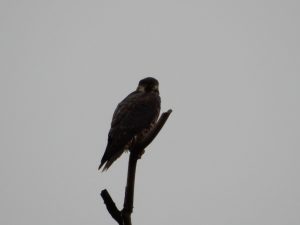
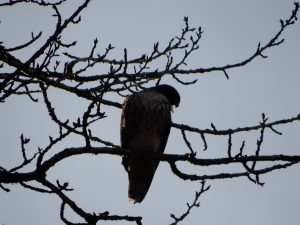 Red-tailed hawk (Buteo Jamaicensis) on a scanning perch that provides an unobstructed 360 degree view of its surroundings before closing the distance to its prey. (Photo by Joshua Joint, taken near Mcallister Creek in Lacey, WA)
Red-tailed hawk (Buteo Jamaicensis) on a scanning perch that provides an unobstructed 360 degree view of its surroundings before closing the distance to its prey. (Photo by Joshua Joint, taken near Mcallister Creek in Lacey, WA)
Dunne, P., & Karlson, K. (2017). Birds of prey: Hawks, eagles, falcons, and vultures of North America. New York, NY: Houghton Mifflin Harcourt.
Crossley, R., Liguori, J., & Sullivan, B. (2013). The Crossley ID guide: Raptors. Princeton, NJ: Crossley Books/Princeton University Press.
Dunne, P. (1988). Hawks in flight: The flight identification of North American migrant raptors. Boston: Houghton Mifflin.
Bird, D. M., Varland, D. E., & Negro, J. J. (1996). Raptors in human landscapes: Adaptations to built and cultivated environments. London: Academic Press.
Stokes, D., Stokes, L., & Hines, B. (1989). A guide to bird behavior. Boston, Mass.: Little, Brown and Company.
Weather-dependent Foraging Success and Sibling Aggression … (n.d.). Retrieved from https://sora.unm.edu/sites/default/files/journals/condor/v082n01/p0076-p0080.pdf
Orourke, C. T., Pitlik, T., Hoover, M., & Fernández-Juricic, E. (2010). Hawk Eyes II: Diurnal Raptors Differ in Head Movement Strategies When Scanning from Perches. PLoS ONE, 5(9). doi:10.1371/journal.pone.0012169
Donohue, K. C., & Dufty, A. M. (2006). Sex determination of Red-tailed Hawks (Buteo jamaicensis calurus) using DNA analysis and morphometrics. Journal of Field Ornithology, 77(1), 74-79. doi:10.1111/j.1557-9263.2006.00003.x
Llerandi-Román, I. C., Rios-Cruz, J. M., & Vilella, F. J. (2009). Cliff-nesting by the Red-tailed Hawk in Moist Karst Forests of Northern Puerto Rico. Journal of Raptor Research, 43(2), 167-169. doi:10.3356/jrr-08-75.1
Hawk Species at Hawk Mountain. (n.d.). Retrieved from http://www.hawkmountain.org/raptorpedia/hawks-at-hawk-mountain/hawk-species-at-hawk-mountain/hawk-species-at-hawk-mountain/page.aspx?id=2879Red Tailed Hawk. (n.d.).
Retrieved from https://www.bioexpedition.com/red-tailed-hawk/
Lovette, I. J., Fitzpatrick, J. W., Brunner, R. M., Freeman, A. C., Bridwell, M. A., & Thompson, M. E. (2017). The Cornell Lab of Ornithology handbook of bird biology. Chichester: John Wiley & Sons.
The current population of Red-tailed hawks is speculated to be anywhere from 500,000 to one million birds. Automobile collisions, nest disrupting, as well as shooting are some threats to the species (Hawks at hawk mountain, 11). There is also mortality risks as the hawks tend to nest on power poles and high voltage transmission towers (Bird, Varland, Negro, 77). It is apparent that human impact such as deforestation and other interferences has the most affect on the hawks and their population.
I am a very avid outdoorsmen who loves hunting, fly fishing and spending as much time possible outdoors observing wildlife. I spent 7 years in the United States Army as a Cavalry Scout and Paratrooper before I decided to seek out a life and career in the outdoors. Preserving and sustaining the natural world is very important and I wish to be a part of it.

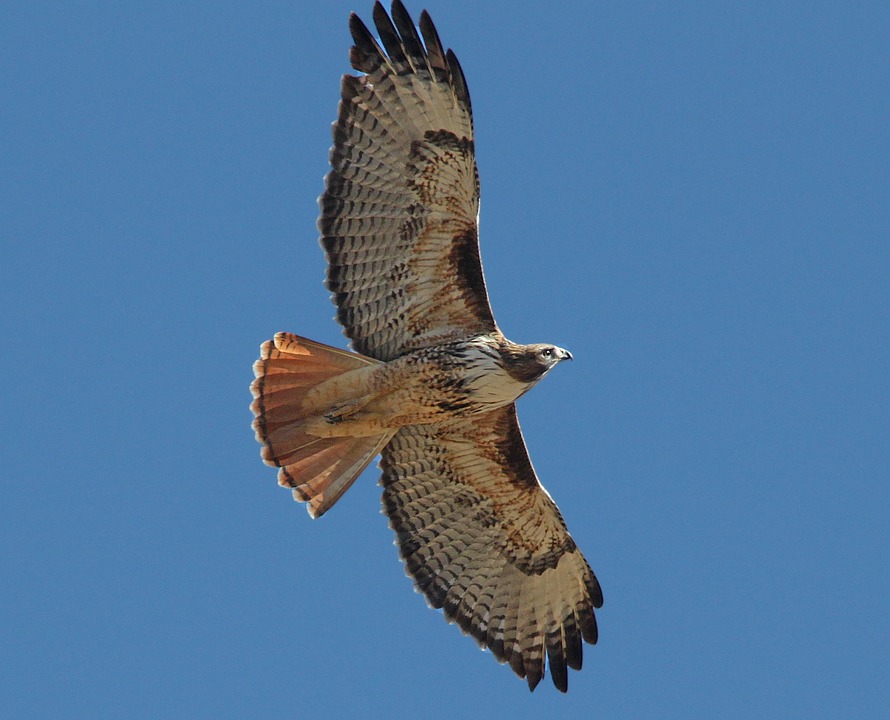
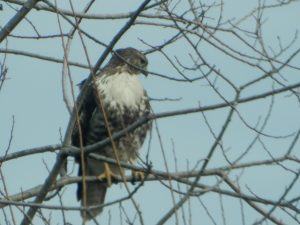
Leave a Reply